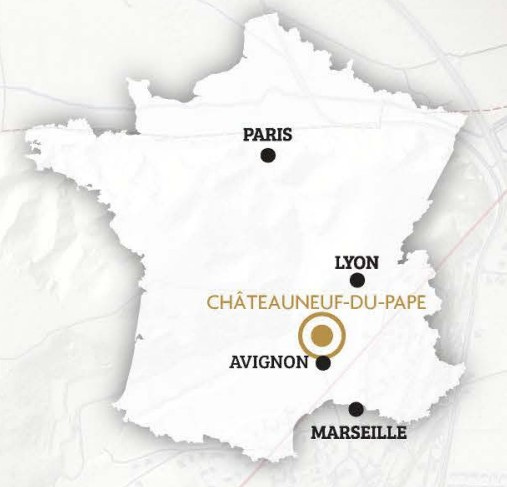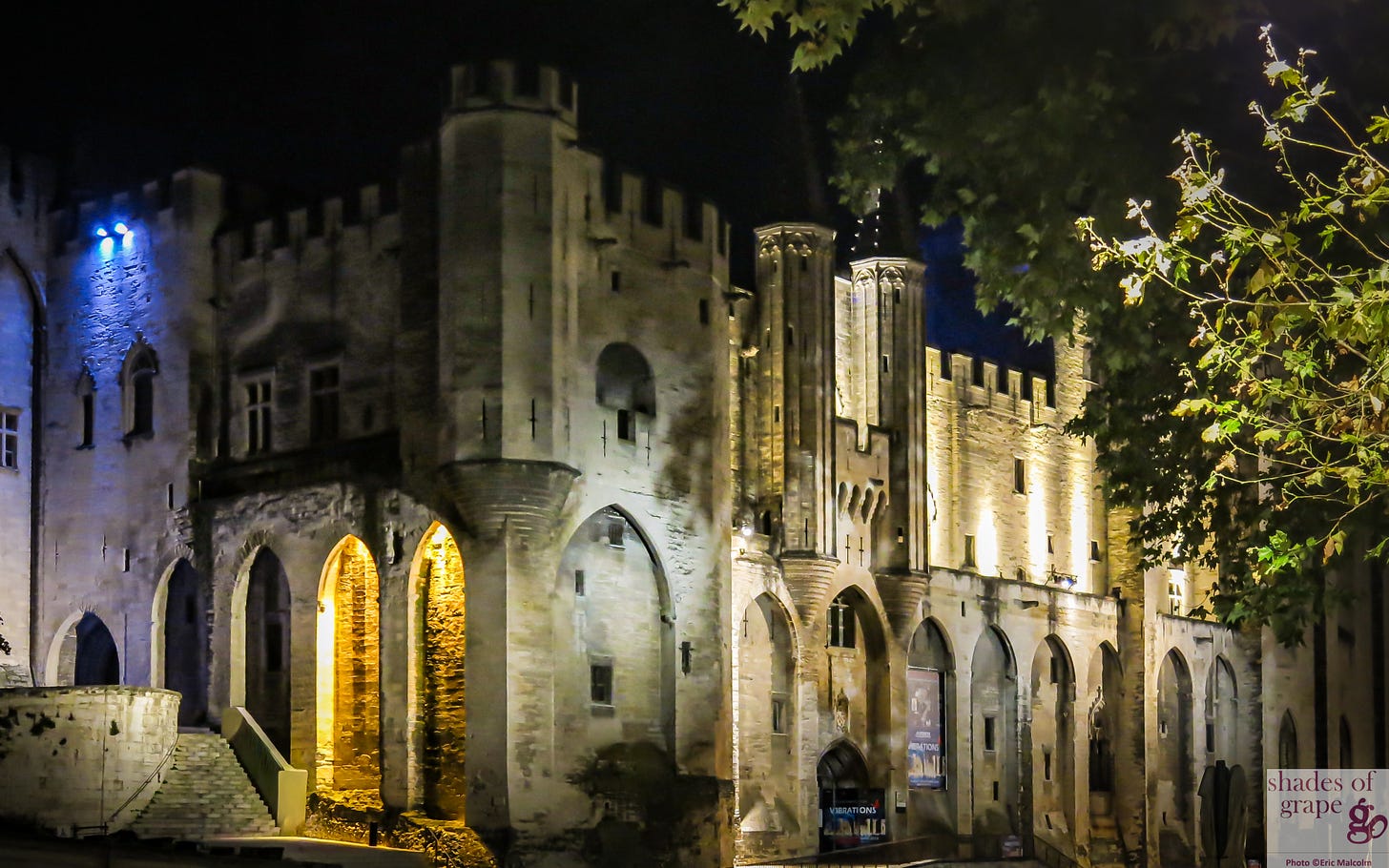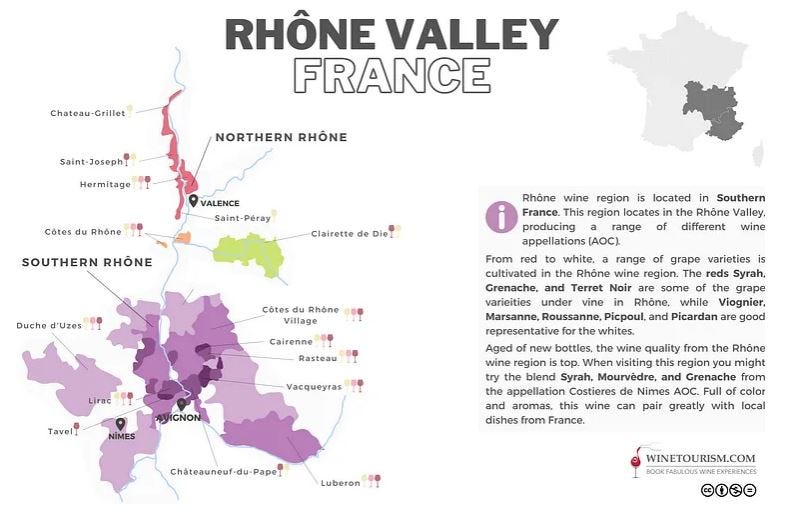Châteauneuf-du-Pape - The OG of French Subregions
-traditional vs. modern winemaking, GSMs, & swooning!
Interested in one-on-one curation time with me? No commitment or minimum purchase required. Flexible appointment times including weekends. Drink better!
Appreciate my wine recommendations? Thanks to all the paid subscribers for their support! Help me continue sharing the world of wine with you!
How do you pick your article topics anyway?
The featured wine is typically the starting point. This week that is particularly true! I had been on the hunt for a Châteauneuf-Du-Pape (CNDP) that both met my expectations and did not completely break the bank.
Define expectations.
Recently, when I try new CNDP wines their style is softer, more elegant. This is what is generally defined as a modern style CNDP. I was looking for a traditional CNDP. In my opinion this is a “true” CNDP, which “should” be a little bolder. More on that later.
Although the Romans planted the subregion’s first vines, the monks and the popes really put it on the map. For more on that - click here and here, with the latter link touching on extraterrestrials in the subregion!
E.T. go home …
I am embarrassed but I don’t know where CNDP is.

It is a subregion within the Southern Rhône Valley.
All that to say I was thrilled to find today’s featured wine. I even texted the importer the night I opened it to say, ‘Thank you’!
A little over the top don’t you think? I feel you swooning over there.
I AM swooning. CNDP is special. It is France’s first subregion (1936). Rap stars love it. The export market loves it (66% by volume of CNDP’s wine was exported in 2021). Of course, the Popes loved it– which is the reason why the wine is called Chateauneuf-du-Pape, which translates to the Pope’s New Castle! I wrote about that here.
In the CNDP subregion the majority of the wines are red (93% red vs. 7% white). Thirteen grapes are allowed to be vinified in these wines. Here are the 18 grapes allowed (black and white).
You just said 13. Sheesh!
That was a test! While you will read about 13 allowed varieties, it depends if we count all the different clones or not! Weird, I know. One of the many inconsistencies in the wine world.
Regardless, here they are:
Grenache (Black, Grey, White), Syrah, Mourvèdre, Cinsault, Clairette (White, Pink), Vaccarèse, Bourboulenc, Roussanne, Counoise, Muscardin, Picpoul (Black, Grey, White), Picardan, and Terret Noir.
This hodgepodge of allowed grapes came to be because in the past they were all growing intermingled on the same parcels of land, which was common in the days of yore!
Unlike many southern France subregions, CNDP surprisingly does not have minimum grape percentage requirements. This means that some CNDP wines are 100% Grenache. Yet most are blended, with the Grenache being the dominant grape for reds and with Syrah and Mourvèdre as the next 2 top blended grapes.
Many hold the misconception that Syrah is the main grape in CNDP, but while it rules the Northern Rhône, Grenache is king of the Southern Rhône. (Learn more about this here, this Rhône article was very popular!!)
Despite the fairly open rules on grape varieties, the CNDP subregion actually DOES have strict rules. Even vine pruning is dictated within the CNDP subregion regulations.
What? That sounds obsessive!
If vines are under 40 years old, a maximum of only 12 buds/vine are allowed. This increases to 15 buds/vine for older vines.
Cuz older vines produce less fruit.
Exactly.
The max grape yield is also set at 35 hectolitres/hectare – one of the lowest in France. Lower yields are one way to increase concentration of aromas and flavors in grapes. The vines can focus their energy on the lower volume of grapes growing.
Earlier I alluded to traditional vs. modern CNDP. This is the first time I introduce this concept within Shades of Grape. But many regions and subregions have these winemaking variations resulting in different styles! It can add confusion as these styles are not labeled.
Traditionally, CNDP wines are made with whole cluster fermentation.
Huh?
This means the grape clusters are not destemmed upon winery reception. The wine is fermented with the stems included. This provides additional tannins, and therefore more structure, to the wines. Since the dominant grape Grenache is lower in tannins the stems are a welcome addition. When in a traditional style, CDNPs are typically moderately-high medium-bodied or full-bodied. They have medium to moderately-high or full tannins that are ripe and very approachable.
The modern version is more elegant. I must watch myself as I do not want to be disparaging, as the market appears to be demanding this from the CNDP subregion. To me however, they are a little thin, meaning they lack body and have less flavor concentration.
This is a perfect segue into my aha moments revolving around my CNDP ‘experiences’. Maybe this would be a good place to ask me about ‘How does this all fit into your personal wine journey’ question?
Okay! How DOES this fit into your personal wine journey?
This was the wine that elevated my game.
My husband worked with a geologist who was into wine. One thing led to another and the three of us and her husband ended up in our kitchen with an evening of homemade pizza and wine.
They brought a CNDP among other wines.
The next morning, I couldn’t stop thinking about the CNDP.
On Monday when my husband and her were debriefing, the CNDP in question came up. I discovered that it was pricier than what I typically spent on wine at the time. Until that point, I did not understand what a price beyond a certain price point wine could bring to a glass. I had tasted many CNDP wines before, but this one was a game changer. In my opinion, it was worth every penny! I still get excited thinking about that night, right down to the details of conversations and cheese pairings!
Wow … now you are definitely swooning!
You bet.
This was a gateway wine for me. A defining moment if you will!
Eventually, I visited CNDP in 2018. I loved every moment and regret not staying longer. I brought some wines home and still can remember everything about them.
As you might expect, this not my only swooning CNDP story, but I do need to move on …
Wow. You are really selling this wine. Who would you recommend this wine to?
Someone who is looking for an epic lamb pairing! (so wonderful!) Or a special beef cut, such as tenderloin or Chateaubriand. These wines are very approachable so they will appeal to many wine drinkers who appreciate European reds, the consumer who is willing to spend a little more on a wine. CNDP is not a cheap wine – You are paying for the subregion.
Okay, well, hard to top that! Let’s scroll down to the highly anticipated featured wine!!
Enjoying my recommendations? Consider upgrading to a paid subscription.
La Ferme Du Mont Châteauneuf-du-Pape ‘Vendange’ 2021 from Southern Rhône, France
Style: Dry Old World Moderately-High Medium Body Red Wine
Varieties: 80% Grenache, 10% Syrah, 10% Mourvèdre
This dynamic wine started with notes of red fruits such as cherry, ripe strawberry, and eventually black cherry, blackberry, black currant, and kirsch entered the fold. The complexity of vanilla, milk chocolate, cinnamon, cedar, and a hint of malt was followed by tobacco, anise, earth, and a touch of thyme upon decantation. The high-quality tannins are abundant, ripe, and fine, and build with decantation. The wine is intensely flavoured and aromatic and has a long finish.
Best pairings: Rack of lamb coated in rosemary and garlic paste, Beef tenderloin seasoned with Herbes de Provence, Rich stews: Osso Bucco, Boeuf Bourguignon, Cassoulet, Moroccan Tagine, Ratatouille, Hard or mature cheeses: Comté, Parmesan, Gruyère or aged Cheddar
Serving Temperature: 15-17 degrees Celsius
Serving Tips: Decant for 1 hour minimum.
Price: ~$75 Cdn
If you're in Alberta and want a one-on-one wine curation experience, please reach out! No commitment or minimum purchase required. Interested? Please reach out!
A huge thank you to my paid subscribers—your support helps cover the costs of creating these weekly articles.
Love my wine recommendations? Enjoy my personal wine curation service? If you find value in my writing, consider upgrading to a paid subscription to help me keep sharing the world of wine with you!
Subscribers receive 15% off Wine & Spirits whenever shopping at Cork Fine Wines, ground floor, Bow Valley Square in Calgary.
SOURCES:
Châteauneuf-du-Pape: The news of Old (2024). https://www.guildsomm.com/public_content/features/articles/b/miquel_hudin/posts/chateauneuf-du-pape-the-news-of-old?utm_source=chatgpt.com.
Domaines du Mont - La Ferme du Mont (no date). https://domainesdumont.com/la-ferme-du-mont/.
Gaztronaut (2016) Beastie Boys, Chateauneuf du Pape. www.wineninjas.org.
Harding, J. and Robinson, J. (2023) The oxford companion to wine. Oxford, United Kingdom: Oxford University Press.
Kimball, R. and Kimball, R. (2022) The heady reds of Avignon. https://thespectator.com/life/the-heady-reds-of-avignon-chateauneuf-du-pape/?utm_source=chatgpt.com.
MacNeil, K. (2022) The wine bible. New York, NY: Workman Publishing.
Maison des vins de Châteauneuf-du-Pape (2025) AOC wine Châteauneuf-du-Pape winemaker association. https://en.chateauneuf.com/.
Wine & Spirit Education Trust (2021) D3: Wines of the World - An accompaniment to the WSET Level 4 Diploma in Wines. Version 1.2. London: Wine & Spirit Education Trust.





It was a pretty crappy wooden chair, actually. You'd think he would have rated some fabric, embroidery, or even a pillow. I guess when you're the alternative Pope, you operate on a tight budget.
Brings back great memories, thank you. When I visited the Pope's Palace in Avignon, I wanted to be photographed smoking a cigar in the Pope's chair, but my wife (who lacks a sense of humor) ruled out the possibility.